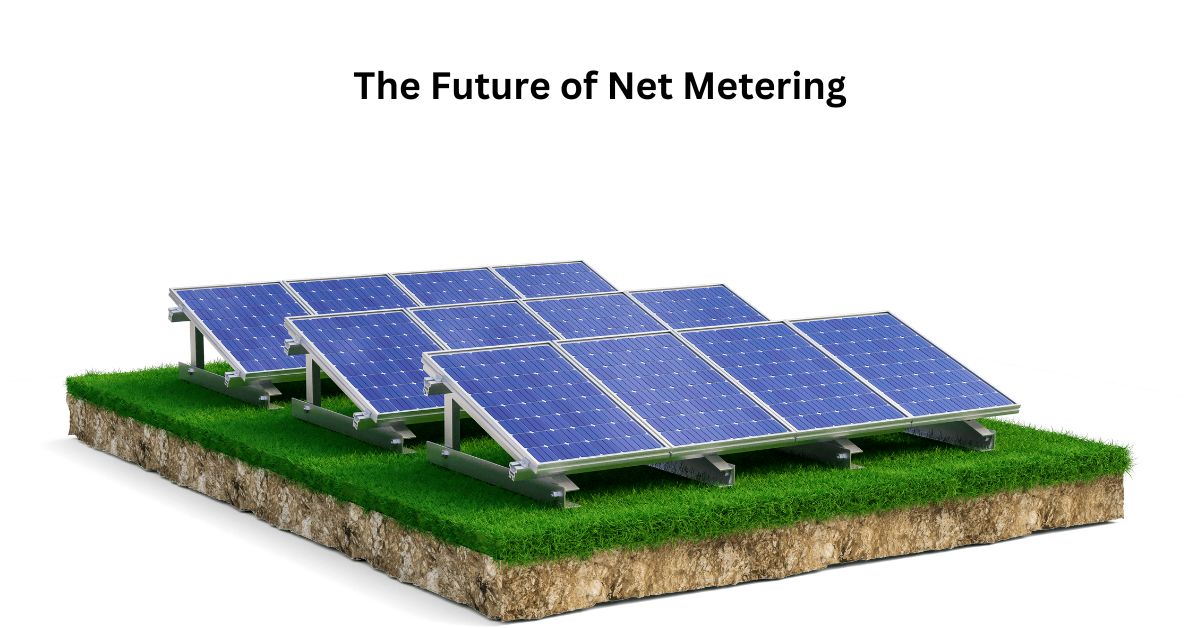Net Metering Solar
Net metering solar is a system that allows homeowners and businesses with solar panels to feed excess electricity they generate back into the grid. When solar energy production exceeds on-site consumption, the surplus is sent to the utility, and customers receive credits for the energy contributed.
These credits offset the cost of electricity used when solar panels aren’t producing enough power, like during nighttime or cloudy days. Net metering creates a financial incentive to invest in solar energy, reduces utility bills, and promotes the efficient use of renewable energy, making it a crucial element in sustainable energy strategies.
Table of Contents
Net Metering Solar: A Comprehensive Guide
The world is increasingly shifting toward renewable energy sources to combat climate change, reduce dependency on fossil fuels, and promote a more sustainable future. Solar energy, in particular, has become one of the most popular choices for clean energy generation due to its abundance and relatively simple installation process. One of the key mechanisms supporting solar energy adoption is net metering, a policy that allows solar energy system owners to sell excess electricity back to the grid. This article will explore the concept of net metering in detail, including its benefits, drawbacks, and its future in the global energy market.
What Is Net Metering?
Net metering is a billing mechanism that allows homeowners or businesses with solar energy systems (or other forms of renewable energy) to receive credit for the excess electricity they generate and export to the grid. The utility companies compensate them by either reducing their electricity bills or offering monetary credits.

The term “net” refers to the balance between the electricity consumed from the grid and the electricity exported back to it. Net metering essentially measures the difference between the energy a customer uses from the grid and the energy the customer’s solar panels produce. This system helps offset electricity costs by using excess solar energy generated during peak sunlight hours to reduce the amount of electricity drawn from the grid during periods of low solar production, such as nighttime or cloudy days.
The concept of net metering has been instrumental in making solar power more accessible to consumers by improving the financial viability of installing a solar energy system.
How Does Net Metering Work?
Net metering relies on a two-way electricity meter, also known as a bi-directional meter, which can track both the inflow (electricity consumed from the grid) and the outflow (excess electricity exported to the grid) of electricity. Here’s how it typically works:
- Generation of Solar Power: During the day, solar panels generate electricity from sunlight. When solar panels produce more electricity than a home or business consumes, the excess electricity is sent back to the local utility grid.
- Energy Flow to the Grid: The two-way meter tracks the amount of electricity flowing back to the grid. This excess energy is credited to the customer’s account at the retail electricity rate in most cases.
- Energy Consumption: At night or during cloudy weather, when the solar system is not generating electricity, customers use electricity from the grid. If they consumed more electricity than they exported, they would be billed for the difference at the end of the billing cycle.
- Balancing the Bill: The electricity exported and consumed is “netted” at the end of the billing period. If the customer exports more energy than consumed, they often receive bill credits that can be applied to future bills.
Benefits of Net Metering
Net metering offers various benefits to homeowners, businesses, and society as a whole. From financial savings to environmental impact, the advantages of this system are a driving force behind the widespread adoption of solar power.
a. Financial Incentives
Net metering provides a compelling financial incentive for installing solar panels. Here’s how:
- Offsetting Electricity Costs: By allowing consumers to earn credits for the excess electricity they generate, net metering reduces their electricity bills. If a household exports more electricity to the grid than it consumes, the credits can be carried forward to future billing cycles, reducing overall energy expenses.
- Faster Payback Period: With reduced electricity bills, the return on investment (ROI) for solar panel installations improves, leading to a quicker payback period. On average, solar systems can pay for themselves within 5 to 10 years, depending on local policies and the system size.
- Increased Property Value: Properties with solar systems that participate in net metering programs often see an increase in value. Potential buyers may be attracted by the lower energy bills and the opportunity to earn credits for any excess electricity generation.
b. Environmental Impact
By incentivizing the adoption of renewable energy, net metering helps reduce greenhouse gas emissions and reliance on non-renewable energy sources.
- Reduction in Carbon Footprint: Solar power generation is a clean and renewable source of energy, meaning it doesn’t produce harmful emissions during operation. By encouraging the use of solar energy, net metering programs contribute to reducing carbon dioxide and other greenhouse gas emissions.
- Reduction in Fossil Fuel Dependency: Countries with strong net metering policies are less dependent on fossil fuels. As solar power adoption increases, it displaces the need for electricity from coal, oil, or natural gas power plants.
c. Grid Stability and Efficiency
Net metering can improve grid stability and efficiency in several ways:
- Distributed Generation: With more households and businesses generating their electricity, there is less strain on centralized power plants. This decentralization of energy generation can reduce transmission losses and improve overall grid efficiency.
- Peak Load Reduction: Solar energy generation tends to peak during the day, coinciding with peak electricity demand (due to air conditioning, for example). Net metering encourages the supply of solar energy to the grid during these high-demand periods, reducing the need for utilities to ramp up production from less efficient and more polluting power plants.
Drawbacks and Challenges of Net Metering
While net metering provides numerous benefits, it also comes with several challenges and criticisms.
a. Impact on Utility Companies
Net metering has created tension between utility companies and solar energy advocates. Some utility companies argue that it leads to revenue losses, as they are required to purchase electricity from solar customers at retail rates rather than the lower wholesale rates they typically pay for electricity from large power plants.

- Revenue Losses: As more households and businesses generate their electricity, utility companies sell less electricity, potentially impacting their revenues. Since utility companies still need to maintain the grid, including transmission lines and infrastructure, some argue that net metering shifts the costs of grid maintenance to non-solar customers.
- Increased Costs for Non-Solar Customers: Some utility companies argue that non-solar customers may end up paying more to cover grid maintenance costs, as solar customers contribute less in the form of electricity bills. This has led to debates over the fairness of net metering programs, particularly in areas where solar adoption is high.
b. Fairness Concerns
The fairness of net metering policies is a subject of ongoing debate. Some concerns include:
- Cross-Subsidization: Critics argue that net metering allows solar customers to avoid paying their fair share of grid maintenance costs, shifting the burden onto non-solar customers. This phenomenon is known as cross-subsidization, where non-solar customers end up subsidizing the costs of maintaining the grid for solar users.
- Compensation Rates: Some utility companies and policymakers argue that net metering customers should be compensated at a lower rate (e.g., wholesale rather than retail) for the electricity they export to the grid. This would reduce the financial incentives for installing solar panels but may address concerns about fairness and grid maintenance costs.
c. Policy Variability
Net metering policies can vary significantly from one region to another, leading to disparities in how solar customers are compensated.
- State and National Differences: In the U.S., for example, net metering policies are determined at the state level, meaning the rules can differ dramatically depending on where a customer lives. Some states have strong net metering programs with generous compensation rates, while others have more restrictive policies.
- Evolving Policies: In some regions, net metering policies are subject to change as utility companies and policymakers respond to the growth of solar energy. This uncertainty can make it difficult for consumers to plan for the long term, as the financial benefits of installing solar panels may change over time.
Net Metering vs. Other Solar Incentives
While net metering is one of the most popular incentives for solar energy, there are other programs designed to encourage the adoption of renewable energy. Some alternatives or complementary programs include:
- Feed-in Tariffs (FiTs): Feed-in tariffs guarantee solar energy producers a fixed payment for every kilowatt-hour (kWh) of electricity they generate and export to the grid, often at above-market rates. FiTs can provide a stable and predictable income stream but differ from net metering in that customers are compensated for all the electricity they produce, rather than just the excess they export.
- Tax Incentives: Many countries offer tax credits, rebates, or other financial incentives to encourage solar adoption. For example, the U.S. offers a federal investment tax credit (ITC) that allows homeowners to deduct a portion of the cost of installing solar panels from their federal taxes.
- Solar Renewable Energy Certificates (SRECs): Some regions have markets for solar renewable energy certificates, where solar energy producers can sell certificates for the clean energy they generate. These certificates provide an additional revenue stream on top of net metering or other compensation programs.
Countries and States Leading in Net Metering Policies
Countries and states that have adopted robust net metering policies have seen significant growth in solar energy adoption. Some of the leading regions include:
- United States: Several states, including California, New York, and Massachusetts, have implemented strong net metering programs that have helped drive the widespread adoption of solar energy. California, in particular, has been a leader in both solar installations and net metering, with more than 1 million solar systems installed as of 2020.
- Germany: Germany’s Energiewende (energy transition) policy has supported the growth of solar energy through a combination of feed-in tariffs and net metering-like mechanisms. While feed-in tariffs have been the primary driver of solar adoption, the country also allows for the self-consumption of solar energy, which can provide additional financial benefits to system owners.
- Australia: Australia has one of the highest rates of residential solar adoption in the world, thanks in part to strong net metering policies and state-level incentives. In some regions, customers receive generous compensation for the excess electricity they export to the grid.
- India: As part of its ambitious renewable energy goals, India has implemented net metering policies in many states to encourage the adoption of solar energy. The country aims to achieve 100 GW of solar capacity by 2022, with net metering playing a key role in reaching this target.
The Future of Net Metering
The future of net metering is likely to be shaped by several factors, including technological advancements, policy changes, and the evolving energy market. Some key trends to watch include:

- Energy Storage Integration: As the cost of energy storage systems (such as batteries) continues to decline, more solar customers may opt to store their excess electricity rather than export it to the grid. This could reduce the need for net metering, as customers would be able to use stored electricity during periods of low solar generation.
- Grid Modernization: As more households and businesses adopt solar energy, utilities may need to invest in grid modernization to accommodate distributed energy generation. Smart grids, advanced metering infrastructure, and improved grid management tools could help utilities better integrate solar energy into the grid while maintaining stability.
- Evolving Compensation Models: In response to concerns about fairness and grid maintenance costs, some regions may transition away from traditional net metering models toward new compensation structures. For example, time-of-use (TOU) rates, which charge customers different rates based on the time of day, could incentivize solar customers to use their electricity during periods of high demand rather than exporting it to the grid.
- Increased Policy Support: Governments around the world may continue to support the growth of solar energy through net metering and other incentives. As climate change becomes an increasingly urgent global issue, policies that encourage the adoption of renewable energy are likely to play a key role in reducing greenhouse gas emissions.
FAQs About Net Metering Solar
Q1. What is net metering?
Net metering is a billing mechanism that allows homeowners with solar panels to send excess electricity generated by their solar system back to the grid in exchange for credits. These credits can then be used to offset the cost of electricity when their system isn’t producing enough power (e.g., at night or during cloudy days).
Q2. How does net metering work?
When your solar panels produce more energy than your home consumes, the excess electricity is sent back to the utility grid. Your utility meter runs backward, and you earn energy credits. When your home uses more energy than your solar system generates, you can draw on those credits to offset your bill.
Q3. Will net metering eliminate my electric bill?
Not necessarily. While net metering can significantly reduce your electricity bill, it won’t eliminate all charges. Some fixed costs, such as connection fees or administrative charges, are typically still required by the utility company.
Q4. What happens to my excess energy credits?
In many net metering programs, excess energy credits roll over to the next billing cycle and can be used to offset future energy use. At the end of the year, depending on the local utility’s policies, unused credits may expire, carry over indefinitely, or be paid out at a wholesale rate.
Q5. Are net metering policies the same in every state?
No, net metering policies vary widely by state and even by utility. Some states offer full retail credit for excess energy, while others offer lower wholesale rates or have limitations on the amount of energy that can be credited.
Q6. Can I use net metering if I have a battery storage system?
Yes, homeowners with battery storage systems can still participate in net metering. Batteries allow you to store excess energy produced during the day for use later, reducing the amount of electricity you draw from the grid and maximizing savings.
Q7. What are the benefits of net metering for solar panel owners?
Net metering allows homeowners to reduce their energy bills, potentially earning credit for excess production and contributing to a cleaner grid. It also shortens the payback period on solar installations, increasing the return on investment (ROI).
Q8. What is the future of net metering?
Net metering is currently under review in many states. Some utilities are pushing for reforms that could reduce the value of credits or add extra charges to solar customers, while others support expanding it to encourage more renewable energy adoption. The future depends on state and local regulatory decisions.
Q9. Can I install a solar system without net metering?
Yes, you can still install a solar system even if your utility doesn’t offer net metering, but the financial benefits might be lower. Without net metering, any excess energy your system produces won’t be credited, meaning you won’t get as much return on your investment.
Q10. Is there a limit on the size of a solar system for net metering?
Many utilities place limits on the size of a solar system that qualifies for net metering, often restricting it to a percentage of the homeowner’s energy consumption or a maximum size measured in kilowatts (kW). Be sure to check with your local utility for specific guidelines.
Net metering has been a driving force behind the widespread adoption of solar energy, offering financial incentives to homeowners and businesses while contributing to a cleaner, more sustainable energy system. While there are challenges and debates surrounding its implementation, the benefits of net metering are clear: reduced electricity bills, lower carbon emissions, and a more resilient and efficient grid.
As the energy landscape continues to evolve, net metering will likely remain an important tool for promoting renewable energy, even as new technologies and policy frameworks emerge. Whether through traditional net metering models or new compensation structures, the transition to a solar-powered future is well underway, and net metering will play a pivotal role in that journey.
Click here to learn more about Net Metering Solar
Click here to learn more about 1kw Solar Panel Size in SQ FT

